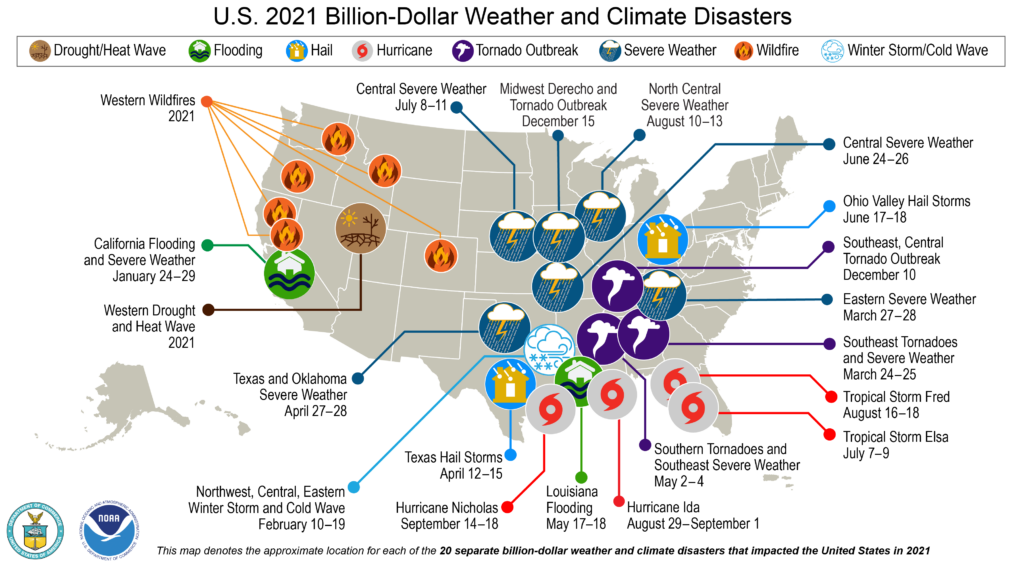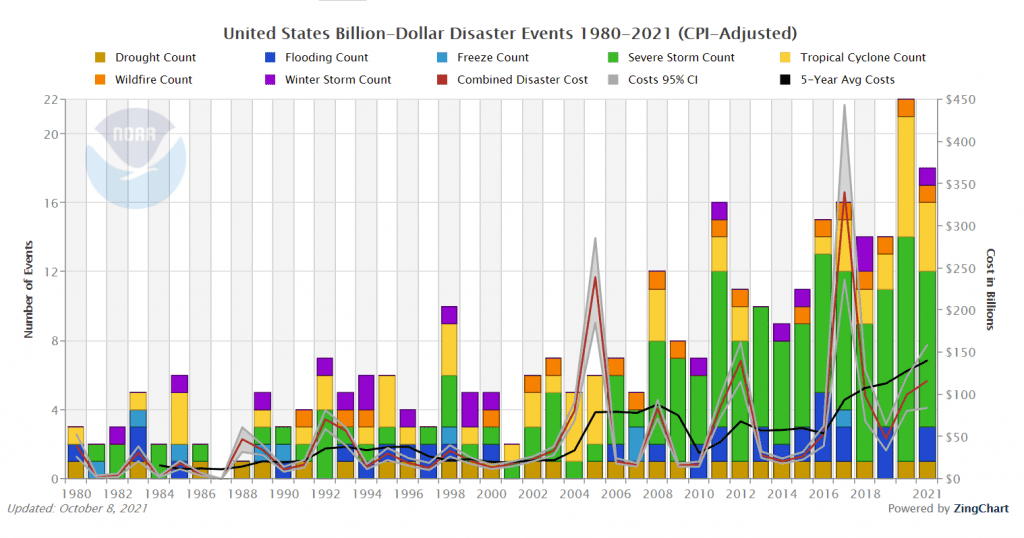As part of the annual convention of the American Meteorological Society (AMS) – the largest gathering of meteorologists in the world – I was invited to take part in a panel on Climate Linked Economics. It was an impressive group, including Steve Bennett, Chief Climate Officer for The Demex Group, Adam Smith, Lead Scientist at the U.S. Billion-Dollar Weather and Climate Disasters program, NOAA, and Josh Darr, Managing Director and Head of North America Peril Advisory at Guy Carpenter.
The discussion cast new insights on climate change’s effects on extreme weather, and the management practices that mitigate short-term business losses and optimize day-to-day operations.
Billion dollar disasters multiply
The panel began with an assessment of the extreme weather events that had major economic impacts last year. During 2021, the U.S. had 20 Billion Dollar Disasters. This billion-dollar classification is a defined benchmark linking weather/climate and economic loss, and these events account for 80-85 percent of economic losses. The major events cause most of the disruptions in the supply chain and subsequent economic losses.
The map below portrays these disasters. Of the Billion Dollar Disasters last year, one was due to drought, two for flooding, 11 for severe storms, four tropical cyclones, one wildfire, and one winter storm. These events resulted in the deaths of 688 people with significant economic effects on the areas impacted. The two costliest events were Hurricane Ida in August ($75B in economic losses) and the Texas Freeze in February ($24B in economic losses).

The rising cost of climate change
The statistics are clear – the frequency of extreme weather events is increasing due to climate change. The graph below shows the frequency of Billion Dollar Disasters from 1980 to 2021 in the U.S. Total losses during this period amounted to 2.15 trillion dollars and the risk has been steadily increased during the past four decades.
Western wildfires, severe storms, inland flooding, and hurricane costs are accelerating at the greatest rate. While much of the discussion surrounded the increase in frequency of extreme events in the U.S., the same trends are occurring across the globe.

The highest-risk U.S. areas for extreme weather and economic losses are the southern and eastern sections of the country. Texas, Louisiana, and Florida are the three states with the most significant losses from 1980 to 2021.
As stated by the IPCC (Intergovernmental Panel on Climate Change) in the last climate assessment, the physical and socioeconomic impacts of compound extreme events can be greater than the sum of the parts.
Weather tops the risk list
The science is clear – extreme weather events are occurring more frequently around the globe. The discussion on climate change, however, has shifted over time.
- 10 years ago, the discussion was “Is climate change happening?”
- Today, it is unequivocal that climate change is happening.
- Increasing regulation will be deployed worldwide in an effort to curb effects.
- Tools will become critical for mitigating risk both from an operational and financial standpoint.
In other words, the pieces are being connected. Predictive analytics are increasingly being used to identify and reduce risk when at all possible.
In the insurance industry, for example, the arena of risk transfer is rapidly changing to manage risk from a financial standpoint. More and more companies are examining their exposure to climate-related risks as a result of the recommendations of the Task Force on Climate-Related Financial Disclosures (TCFD), credit rating agencies, and other bodies.
Millions of businesses operate daily knowing that extreme weather (as influenced by a changing climate) leads to unplanned fluctuations in profitability. The Global Risks 2020 report produced by the World Economic Forum said “…environmental risks have grown in prominence in recent years. For the first time, ‘extreme weather events,’ ‘natural disasters,’ and ‘failure of climate change mitigation and adaptation’ are in the top five global risks for both impact and likelihood of occurrence within the next ten years.
Jon Davis is Chief Meteorologist for Everstream Analytics.